TRANSURETHRAL
RESECTION OF THE PROSTATE FOR THE TREATMENT OF LOWER URINARY TRACT SYMPTOMS
RELATED TO BENIGN PROSTATIC HYPERPLASIA: HOW MUCH SHOULD BE RESECTED?
(
Download pdf )
doi: 10.1590/S1677-55382009000600007
ALBERTO A. ANTUNES, MIGUEL SROUGI, RAFAEL F. COELHO, KATIA R. LEITE, GERALDO DE C. FREIRE
Division of Urology, University of Sao Paulo Medical School, Sao Paulo, SP, Brazil
ABSTRACT
Objective:
To assess the impact of the percent of resected tissue on the improvement
of urinary symptoms.
Materials and Methods: The study included
a prospective analysis of 88 men with benign prostatic hyperplasia. Patients
were divided in three groups according to the percent of resected tissue:
Group 1 < 30%; Group 2, 30% to 50%; and Group 3, > 50%. Each patient
was re-evaluated 3 months after surgery. We assessed the international
prostatic symptom score, nocturia and serum prostate specific antigen
levels.
Results: All patients presented a significant
decrease on mean International Prostate System Score (IPSS) (23 to 5.9),
Quality of Life (QoL) (4.9 to 1.0) and nocturia (3.2 to 1.9). Variation
in the IPSS was 16.7, 16.6 and 18.4 for patients from Group 1, 2 and 3
respectively (P = 0.504). Although the three groups presented a significant
decrease in QoL, patients in Group 3 presented a significantly greater
decrease when compared to Group 1. Variation in QoL was 3.1, 3.9 and 4.2
for patients from Group 1, 2 and 3 respectively (p = 0.046). There was
no significant difference in nocturia variation according to the percent
of resected tissue (p = 0.504). Median pre and postoperative PSA value
was 3.7 and 1.9 ng/mL respectively. Patients from Group 1 did not show
a significant variation (p = 0.694). Blood transfusions were not required
in any group.
Conclusions: Resection of less than 30%
of prostatic tissue seems to be sufficient to alleviate lower urinary
tract symptoms related to benign prostate hyperplasia. However, these
patients may not show a significant decrease in serum PSA level.
Key
words: prostate; benign prostatic hyperplasia; transurethral
prostatectomy; symptom score; organ weight
Int Braz J Urol. 2009; 35: 683-91
INTRODUCTION
Benign
prostatic hyperplasia (BPH) is the most common benign neoplasm in men.
By the age of 60, half of all men have histological evidence of BPH and
virtually all men have it by the age of 80 (1). Additionally, in a recent
retrospective study of more than one million men 50 years of age or older
in a managed care population from United States, BPH was among the four
prevalent diagnoses (2).
Despite the development of new minimally
invasive methods, transurethral resection of the prostate (TURP) remains
the gold standard surgical treatment for lower urinary tract symptoms
(LUTS) related to BPH, with more than 90% of the patients reporting normal
or improved voiding, after 10-year follow-up period (3,4). The recommended
technique of TURP consists of complete removal of all adenomatous tissue
inside the surgical capsule (5). However, complication rates seem to be
related to resection time and the amount of resected tissue (6), and historical
data has shown that the amount of resected tissue during TURP has decreased
significantly over the last 10 years (7,8).
In fact, to date there is no consensus regarding
what amount of tissue should be resected during TURP. While some authors
have suggested that better clinical results after TURP may correlate with
the completeness of the resection of the obstructing adenoma (9,10), others
have shown that partial resection produces short-term functional results
comparable to those of standard TURP (11,12). The aim of this study was
to evaluate the impact of the percent of resected tissue (PRT) during
TURP on the short-term clinical outcome of patients with LUTS due to BPH.
MATERIALS AND METHODS
The
study comprised a prospective analysis of a cohort of 144 consecutive
men who underwent TURP for treatment of LUTS due to BPH between February
2006 and June 2007. After exclusion of 56 cases that were treated for
urinary retention, the final sample comprised of 88 patients. All these
patients had moderate or severe LUTS that were refractory to medical treatment
and were at least dissatisfied with their urinary condition. Patients
with neurogenic bladder or prostatic carcinoma were not considered for
analysis.
All patients underwent detailed physical
examination including digital rectal examination, blood chemistry, urine
analysis and serum prostate specific antigen (PSA) test. For assessment
of LUTS and QoL, we used the International Prostate Symptom Score (IPSS)
(13) and its appended 8th question related to quality of life (QoL). PSA
behavior was also analyzed. Prostate volume was measured through abdominal
ultrasound and estimated as length x width x height x 0.52. All patients
were operated on under spinal anesthesia with a 24-French Storz continuous-flow
resectoscope and a standard loop. The resected tissue was systematically
weighed immediately after the surgical procedure. Perioperative complications
were recorded if present. The urethral Foley catheter was removed from
all patients 48 hours after TURP and they were discharged home on the
third postoperative day. They were re-evaluated at 3 months for LUTS,
QoL, nocturia and serum PSA levels.
The PRT was calculated as the resected tissue
weight divided by the preoperative ultrasound prostate volume measurement
x 100. Patients were divided in three groups according to the PRT: Group
1 < 30%; Group 2 = 30% to 50%; and Group 3 > 50%. Table-1 shows
the baseline demographic characteristics of the three study groups. Mean
patient age, IPSS, nocturia, duration of symptoms, prostate weight and
serum PSA levels were similar between the groups. Regarding QoL, patients
from Group 3 presented a marginally significant higher mean score when
compared to patients from Group 1.
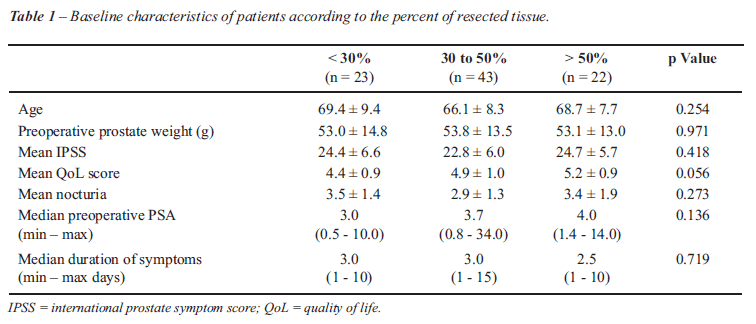
Since for the patient the most important
outcome parameter is satisfaction with symptomatic improvement, primary
end point was a change in QoL score according to the PRT. Secondary end
points were a change in IPSS, nocturia or serum PSA levels. For statistical
analysis we used the ANOVA test. Statistical analysis was performed using
the SPSS 12.0 for Windows software and significance was set as p = 0.05.
RESULTS
Mean resected tissue weight was 12.4 ± 4.4, 22.3 ± 7.4 and 33.8 ± 6.1 grams for patients from group 1, 2 and 3 respectively (p < 0.001). Mean pre and postoperative QoL score was 4.9 ± 1.0 and 1.0 ± 1.0 respectively. The three groups showed a significant improvement in QoL (mean 3.7 ± 0.3; p < 0.001), however, patients from Group 3 when compared to patients from Group 1 presented a significantly greater decrease (p = 0.046). Variation in QoL was 3.1 ± 0.3, 3.9 ± 0.2 and 4.2 ± 0.3 for patients from group 1, 2 and 3 respectively (Figure-1).
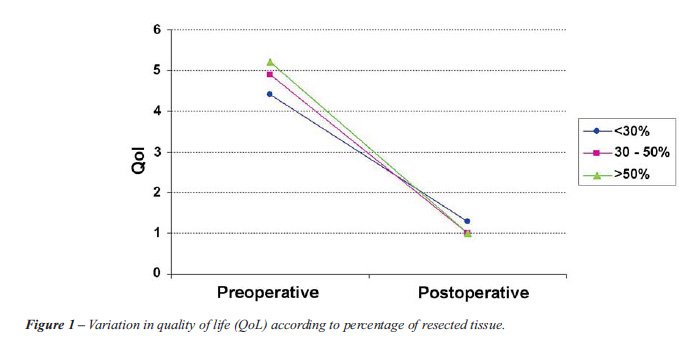
Mean pre and postoperative IPSS was 23.0
± 5.6 and 5.9 ± 4.6 respectively. There was a significant
decrease in IPSS among the three study groups (mean 17.1 ± 0.7;
p < 0.001), but despite a slight greater variation among patients from
group 3, no significant statistical difference in the IPSS variation according
to the PRT was observed (p = 0.561). Variation in IPSS was 16.7, 16.6
and 18.4 for patients from group 1, 2 and 3 respectively (Figure-2).
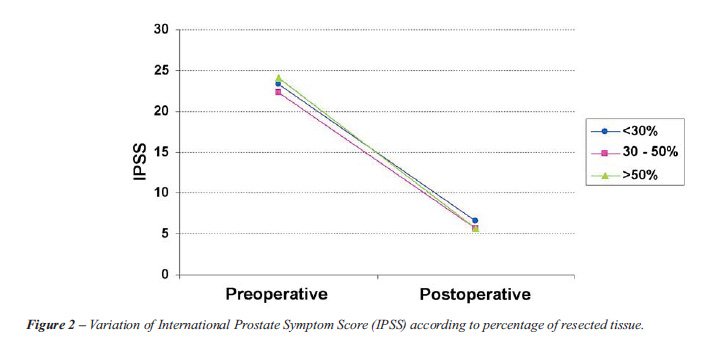
Mean pre and postoperative nocturia was
3.2 ± 1.5 and 1.9 ± 1.3 respectively. Again, the 3 groups
presented a significant decrease in nocturia (mean 1.4 ± 0.2; p
< 0.001). There was no significant difference in nocturia variation
according to the PRT (p = 0.504). Postoperative nocturia was 1.8 ±
1.3, 1.7 ± 1.4 and 2.0 ± 1.4 for patients from Group 1,
2 and 3 respectively (Figure-3).
Median pre and postoperative PSA value was 3.7 ng/mL (0.3 - 24.8) and
1.9 ng/mL (0.2 - 11.0) respectively. While patients from group 2 and 3
presented a significant drop in PSA levels (p = 0.003 and p = 0.002 respectively),
patients from Group 1 did not show a significant variation in PSA levels
(p = 0.694). Median postoperative PSA levels were 2.4 (0.2 - 11.0), 1.4
(0.4 - 5.9) and 1.15 (0.3 - 5.4) for patients from Group 1, 2 and 3 respectively
(Figure-4). Blood transfusions were not required in any group.
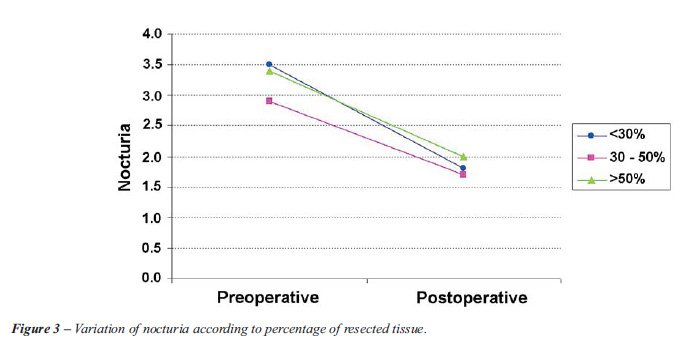
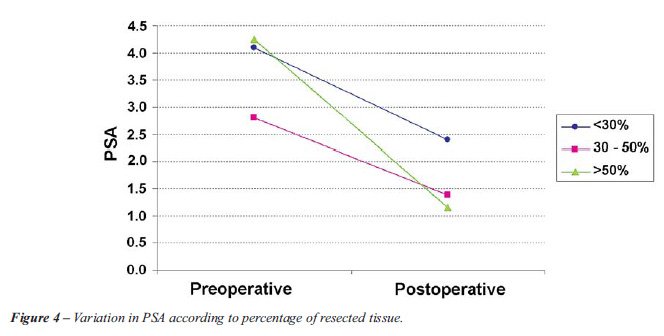
COMMENTS
The
present study demonstrated that the amount of resected tissue seems to
have little impact on the short-term clinical outcome after TURP. Although
patients who had more than 50% of the prostatic tissue resected presented
a significantly greater decrease in QoL score when compared to patients
in Group 1, both groups presented a significant decrease when analyzed
individually. Variations in IPSS were also slightly greater among patients
from Group 3, but this figure was not statistically significant. Nocturia
was not influenced by the PRT.
Despite the proven efficacy of TURP, the
question of how much prostatic tissue should be resected has existed for
more than 70 years. While McCarthy stated in 1931 that resection of median
and lateral lobes should be performed until a free view into the bladder
was obtained, Blandy stated in 1978 that total resection of the adenoma
inside the surgical capsule between the bladder neck and the verumontanum
was necessary (12).
The recommended TURP technique consists
of complete removal of the entire adenoma inside the surgical capsule
(5). However, when performed in medically compromised elderly patients
with large prostates, this procedure may be associated with troublesome
bleeding and irrigating fluid absorption leading to TURP syndrome. Data
from 3861 consecutive patients with BPH who underwent TURP from 1971 to
1996 demonstrated that mortality, morbidity, and blood transfusions were
observed in 0.1%, 13.4% and 13.1% patients, respectively. The most significant
risk factors for blood transfusion were related to resection time, the
amount of tissue resected, age, and the decade in which the surgery was
performed (6). Regarding TURP syndrome, Mebust et al. (14), showed that
its incidence was greater in resections lasting longer than 90 minutes
and in those producing more than 45 grams of tissue. In the present series,
25% of the patients had more than 50% of the prostates resected, and no
case required blood transfusions or developed TURP syndrome.
To date, there is still no consensus regarding
the amount of prostatic tissue that should be resected during TURP. Despite
the initial recommendations by Nesbit (5), historical data has shown that
the amount of resected tissue has decreased significantly over time (7,8).
In the study of Borth et al. (7), mean weight of tissue resected in 1988
was 16.5g and decreased to 12.5g in 1998. In the series of Vela-Navarrete
et al. (8), mean volume resected in 1992 was 35.7 mL and decreased to
24.3 mL in 2002. In the series of Green et al. (15), which analyzed 432
patients who underwent TURP, the mean weight of tissue resected was 25.6
g and no surgeon resected more than 50% of the gland volume. In the present
series the mean resected tissue weight was 22.3 ± 10.2 grams, which
corresponded to a mean 42% of PRT.
Data analyzing the outcome of patients who
underwent complete or partial TURP have led to controversial results.
In the study of Chen et al. (9), these authors found a good relationship
between residual prostate weight ratio (weight after TURP divided by the
preoperative prostate weight) and clinical outcome variables among 40
patients who underwent TURP and were followed-up for 16 weeks. Their results
suggest that the better clinical results after TURP correlate significantly
with the completeness of the resection of the obstructing adenoma.
Conversely, Aagaard et al. (11) prospectively
assessed the long-term results of total TURP and minimal TURP in 167 patients
with obstructive symptoms caused by BPH and found that a significant relief
in obstructive and irritative symptoms was observed in both groups. Maximum
flow rate and post-void residual urine improvement were also similar between
the groups. Similarly, more recently, Agrawal et al. (12), in a prospective
and randomized study compared the hemiresection (complete resection of
one lateral lobe and the median lobe, if present) of the prostate to the
standard TURP. They found that the 2 groups had comparable improvement
in symptom scores and flow rates. Two patients required blood transfusions
and two developed TURP syndrome in the standard resection group and no
complications were observed in the hemiresection group.
PSA behavior after TURP is crucial during
patient follow-up and a subsequent rise in PSA may indicate prostate biopsy.
Studies have shown that PSA decreases drastically in patients who undergo
TURP. Fonseca et al. (16), showed that mean PSA levels declined 71% after
TURP, and 60 days after surgery the reduction reached its peak, stabilizing
afterwards. Mean PSA varied from 6.1 ng/mL before surgery to 1.7 ng/mL
after 60 days postoperatively. In the present series we demonstrated that
the amount of resected tissue might significantly influence PSA reduction.
Variation in PSA among patients who had less than 30% of prostate resected
was not significant and median postoperative PSA in this group was 2.4
ng/mL (0.2 - 11.0). Urologists must take into account the PRT when analyzing
the serum PSA in patients who have undergone TURP.
Some methodological limitations of the present
study must be considered. We did not analyze LUTS function through objective
measurements such as flow rates or residual urine. According to the American
Urological Association guidelines these are optional assessments for patients
with BPH who are candidates for surgical treatment (17). Follow-up was
limited, however, the scope of the study was to assess symptom relief
and previous data have suggested that no further symptom improvement would
be observed after 3 months of TURP (10). Finally, prostate volume was
measured by suprapubic rather than transrectal ultrasound. However, while
the transuretral route is considered to be more accurate in prostate size
determination, similar limitations exist for both methods (18).
CONCLUSIONS
Resection of less than 30% of prostatic tissue seems to be sufficient to alleviate LUTS related to BPH. However, these patients may not show a significant decrease in the serum PSA level. Analysis of PSA in men who have undergone TURP must take into account the PRT. Patients with more than 50% of resected tissue may present a greater variation in QoL scores.
CONFLICT OF INTEREST
None declared.
REFERENCES
- Berry SJ, Coffey DS, Walsh PC, Ewing LL: The development of human benign prostatic hyperplasia with age. J Urol. 1984; 132: 474-9.
- Issa MM, Fenter TC, Black L, Grogg AL, Kruep EJ: An assessment of the diagnosed prevalence of diseases in men 50 years of age or older. Am J Manag Care. 2006; 12(4 Suppl): S83-9.
- Rassweiler J, Teber D, Kuntz R, Hofmann R: Complications of transurethral resection of the prostate (TURP)--incidence, management, and prevention. Eur Urol. 2006; 50: 969-79; discussion 980.
- Thomas AW, Cannon A, Bartlett E, Ellis-Jones J, Abrams P: The natural history of lower urinary tract dysfunction in men: minimum 10-year urodynamic followup of transurethral resection of prostate for bladder outlet obstruction. J Urol. 2005; 174: 1887-91.
- Nesbit RM: Transurethral prostatic resection. In: Campbell L, Harrison J (ed.), Urology. Philadelphia, Sounders. 1970; pp. 2479.
- Uchida T, Ohori M, Soh S, Sato T, Iwamura M, Ao T, et al.: Factors influencing morbidity in patients undergoing transurethral resection of the prostate. Urology. 1999; 53: 98-105.
- Borth CS, Beiko DT, Nickel JC: Impact of medical therapy on transurethral resection of the prostate: a decade of change. Urology. 2001; 57: 1082-5; discussion 1085-6.
- Vela-Navarrete R, Gonzalez-Enguita C, Garcia-Cardoso JV, Manzarbeitia F, Sarasa-Corral JL, Granizo JJ: The impact of medical therapy on surgery for benign prostatic hyperplasia: a study comparing changes in a decade (1992-2002). BJU Int. 2005; 96: 1045-8.
- Chen SS, Hong JG, Hsiao YJ, Chang LS: The correlation between clinical outcome and residual prostatic weight ratio after transurethral resection of the prostate for benign prostatic hyperplasia. BJU Int. 2000; 85: 79-82.
- Hakenberg OW, Helke C, Manseck A, Wirth MP: Is there a relationship between the amount of tissue removed at transurethral resection of the prostate and clinical improvement in benign prostatic hyperplasia. Eur Urol. 2001; 39: 412-7.
- Aagaard J, Jonler M, Fuglsig S, Christensen LL, Jorgensen HS, Norgaard JP: Total transurethral resection versus minimal transurethral resection of the prostate--a 10-year follow-up study of urinary symptoms, uroflowmetry and residual volume. Br J Urol. 1994; 74: 333-6.
- Agrawal MS, Aron M, Goel R: Hemiresection of the prostate: short-term randomized comparison with standard transurethral resection. J Endourol. 2005; 19: 868-72.
- Barry MJ, Fowler FJ Jr, O’Leary MP, Bruskewitz RC, Holtgrewe HL, Mebust WK, et al.: The American Urological Association symptom index for benign prostatic hyperplasia. The Measurement Committee of the American Urological Association. J Urol. 1992; 148: 1549-57; discussion 1564.
- Mebust WK, Holtgrewe HL, Cockett AT, Peters PC: Transurethral prostatectomy: immediate and postoperative complications. a cooperative study of 13 participating institutions evaluating 3,885 patients. 1989. J Urol. 2002; 167: 999-1003; discussion 1004.
- Green JS, Bose P, Thomas DP, Thomas K, Clements R, Peeling WB, et al.: How complete is a transurethral resection of the prostate? Br J Urol. 1996; 77: 398-400.
- Fonseca RC, Gomes CM, Meireles EB, Freire GC, Srougi M: Prostate specific antigen levels following transurethral resection of the prostate. Int Braz J Urol. 2008; 34: 41-8.
- AUA Practice Guidelines Committee: AUA guideline on management of benign prostatic hyperplasia (2003). Chapter 1: Diagnosis and treatment recommendations. J Urol. 2003; 170: 530-47.
- Matthews GJ, Motta J, Fracehia JA: The accuracy of transrectal ultrasound prostate volume estimation: clinical correlations. J Clin Ultrasound. 1996; 24: 501-5.
____________________
Accepted after revision:
June 3, 2009
_______________________
Correspondence address:
Dr. Alberto Azoubel Antunes
Rua Barata Ribeiro, 490 / 76
Sao Paulo, 01308-000, Brazil
Fax: +55 11 3255-6372
Email: antunesuro@uol.com.br
EDITORIAL COMMENT
Antunes
and coauthors investigated the impact of the percent of resected tissue
(PRT) on the improvement of lower urinary tract symptoms (LUTS). They
found that resection of less than 30% of prostatic tissue was sufficient
to alleviated LUTS although a significant variation on PSA levels was
not observed in this group. From the perspective of subjective outcome,
the authors’ observations indicate that symptom improvement can
be achieved regardless of the PRT.
I do not believe that LUTS is always due to enlarged prostate. I do believe
that LUTS does not need to always be related to prostate enlargement.
For example, Asian men have a similar frequency of prostatic obstruction
and more severe symptoms despite having a smaller prostate volume (1,2).
Thus, there is some reason in authors’ results. However, since the
authors could not provide objective data such as maximum flow rate, post-void
residual, frequency-volume charts, it is unknown whether these objective
parameters may also be improved regardless of the PRT. In addition, we
cannot know the lower limit of PRT for alleviating LUTS based on authors’
results. Furthermore, although TURP is a truly ablative procedure for
obstruction, authors did not perform pressure-flow studies. Thus, we do
not know how many patients who have detrusor underactivity or bladder
outlet obstruction were included in this study.
In summary, the value of the findings of Antunes and co-authors remain
unknown. Therefore, further studies are needed to answer the question
about the PRT for the improvement of LUTS/BPH and its possible mechanism.
REFERENCES
- Choi J, Ikeguchi EF, Lee SW, Choi HY, Te AE, Kaplan SA: Is the higher prevalence of benign prostatic hyperplasia related to lower urinary tract symptoms in Korean men due to a high transition zone index? Eur Urol. 2002; 42: 7-11.
- Tsukamoto T, Kumamoto Y, Masumori N, Miyake H, Rhodes T, Girman CJ, et al.: Prevalence of prostatism in Japanese men in a community-based study with comparison to a similar American study. J Urol. 1995; 154: 391-5.
Dr.
Jae-Seung Paick
Department of Urology
Seoul National University Hospital
Seoul, Korea
E-mail: jspaick@snu.ac.kr
EDITORIAL COMMENT
In this
paper Antunes et al. address the correlation between the amount of resected
tissue during transurethral resection of the prostate (TURP) for benign
prostatic hyperplasia (BPH) and the outcome of the procedure. Their conclusions
are that “resection of less than 30% of prostatic tissue seems to
be sufficient to alleviate lower urinary tract symptoms (LUTS) related
to BPH”.
On one hand, our classical idea of TURP is as much as complete removal
of adenomatous tissue, mimicking an open simple prostatectomy, especially
when operating on healthy patients without high surgical risk. On the
other hand, the concept by Antunes et al. might sound really appealing
because it obviously means reduced operative time and operative risks,
as we all know that complications of TURP are related to the duration
of the procedure, and it also means expanding indications of TURP to larger
prostates.
However, we think that their final message can be misleading and the results
have to be critically analyzed as the study suffers from some major methodological
flaws.
Regarding the study rationale: how can you offer patients a procedure
that is planned as “incomplete” from the beginning; how do
you inform the patients, in this series who are not too old and probably
have a low ASA score, about the procedure ?
The authors divided their patients in 3 cohorts according to the amount
of resected tissue. Unfortunately, from a methodological point of view,
this was the result of a retrospective analysis, while they ought to stratify
and then randomize the patients preoperatively. Moreover, the operator
should know exactly when to stop before beginning the procedure not while
operating. As no selection criteria are reported one can imagine that
the operator decided arbitrarily to stop the resection based on personal
experience. However, TURP is the gold standard in surgical treatment of
BPH because the technique has been standardized following specific anatomic
landmarks so that results among different centers can be compared.
Which patient would benefit from a less than 30% TURP? Will we ever be
able to understand when 30% (of adenomatous tissue or of the whole gland?)
has been resected? How will we teach trainees to stop resection in order
to gain good functional results? In our personal experience we had, of
course, cases where we had to stop resecting because extensive blood loss
or general perioperative complications occurred. And most of them functionally
did fairly well afterwards.
As recognized by the authors themselves, objective outcome parameters,
i.e. maximum urinary flow rate (Qmax) and post voiding residual urine
volume (PRV), are missing here. Actually, it is suggested by some authors
that a pressure/flow study had to be done when acting within the framework
of a clinical trial. Moreover, the follow-up (3 months) is really too
short here (also considering from current literature long-term data are
already available for TURP). And the problem is not that, as the authors
commented, “no further improvement might be observed…”.
In contrast, a worsening of the symptoms can be observed. That is why
long-term data are needed when evaluating any new minimally invasive surgical
procedure for BPH treatment.
In conclusion, we completely agree that “for the patient the most
important parameter is satisfaction with the symptomatic improvement”.
This is the reason why we will continue to perform and to teach a complete
TURP until a reproducible “mini-TURP” technique is established.
Dr.
Riccardo Autorino &
Dr. Marco De Sio
Clinica Urologica
Seconda Università degli Studi
Napoli, Italy
E-mail: ricautor@tin.it